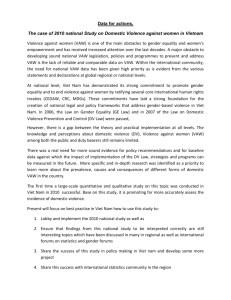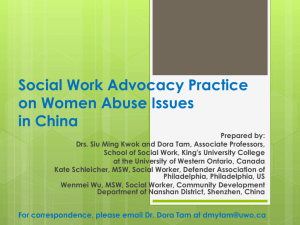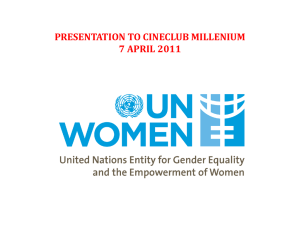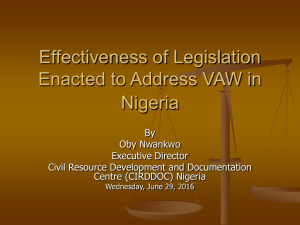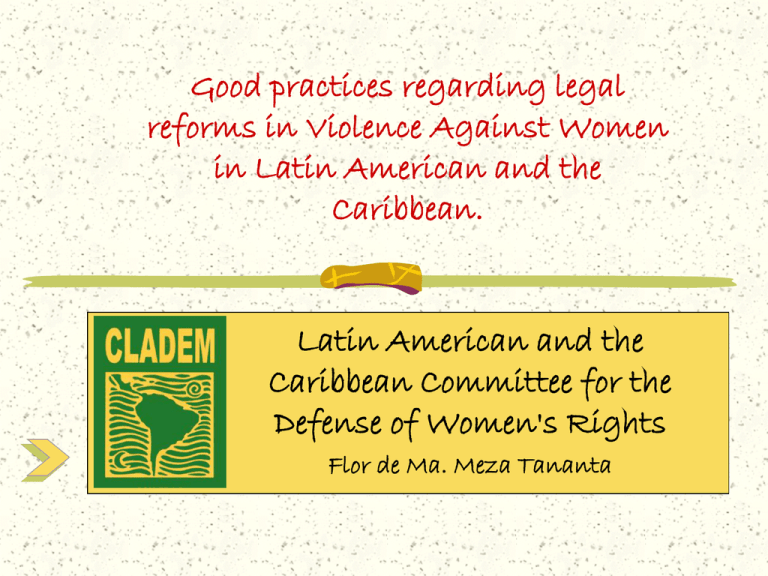
Good practices regarding legal
reforms in Violence Against Women
in Latin American and the
Caribbean.
Latin American and the
Caribbean Committee for the
Defense of Women's Rights
Flor de Ma. Meza Tananta
Index
Contextual Framework
Legislation on dv/ Sexual violence in the
ISHR
Amendments to the penal Codes: SV
Trafficking of latinamerican women
Difficulties to the implementation of
the legal reforms
Good practices within the IA System: case
MM
1. Contextual framework
•being a woman and being poor in LA
constitutes a life risk.
•If we add other factors such as being
young, indigenous or afrodescendant, then
the risk increases.
•These factors have motivated that from the
early 90s in LA region we refer to femicide.
What does the term femicide mean?
Definition: All violent deaths of women
which imply intention in the execution of
these acts:
(i)Serial sexual murders
(ii) Deaths due to domestic or family
violence
(iii) Deaths framed within the scope of
actions of the organized crime;
prostitution; drug trafficking; women
trafficking; sexual explotation of children.
The InterAmerican Convention To prevent,
Sanction and erradicate VAW.
Convention
do Belem
do Pará
32/34 member
States of OAS
Have ratified
this
Convention.
• Describes the obligations of the States Parties
with respect to the protection of those rights,
among others.
• However the Rapporteur on Women Human
Rigths of the OAS said: “The Interamerican
CHR observes that the big majority of the
cases of VAW are shadowed by impunity
which contributes to perpetuate this serious
violation of human rights”
None of the 32 countries that ratified the
25 countries have
partially implemented
their commitments
promulgating
laws only on DV/FV.
With this commitment
against FV we are not
really protecting
women against
violence because the
whole family is taken in
to account first.
The woman becomes
an invisible member of
the family.
Convention of Belem do Pará have exactly
fulfilled its regulations.
Most of the legislations on DV have
incorporated physical and psychological
violence whereas some other countries also
contemplate sexual and patrimonial
violence.
Several countries of LA have modified their
penal legislation to criminalize conducts AW,
especially the ones concerning on SV.
Some countries maintain discriminatory
terms referred to the honesty of women.
In most countries of LA we still don´t have a
law that punishes a husband who rapes his
wife.
Difficulties referred to the implementation
of the legal reforms
Erradicating gender based violence is a process which
requires cultural changes that must be socially accepted.
There have been improvements in the American legislation
but they are not fully implemented due to following reasons:
Absence of economic material resources for the
effective implementation of the legal reforms on VAW.
Absence of recognition that VAW is a violation of
women´s human rights.
Lack of sensibility and qualification of social
operators, especially the legal operators with respect
to the reforms on VAW.
Difficulties referred to the implementation
of the legal reforms
Re-victimization, prejudiced and discriminatory
treatment to the victims of violence by government
officers.
The lack of material and human resources for a
suitable attention to the victims.
The ignorance of women in relation to their rights.
VAW continues to be internalized as a “natural and
invisible” practice in our societies.
Good practices within the IS:
“Maybe I had a Right”
The facts: On January 25th 1996, MM went to the hospital of
the city of Juliaca, Puno, Peru, due to strong headaches
that she was suffering. She was assisted by doctor
Salmon Horna. He gave her anesthetic and this put her in
a state of unconsciousness. Then he raped her. MM
denounced Dr. Horna accusing him of rape. “It was an
aberrant judgement, all the process was a scandal”. The
magistrates acted with bias, prejudice and inequity.
The agreement: On march 2000 an agreement between the
petitioners and the Peruvian State was signed. The
Peruvian State accepted to repair the moral and material
damage caused to MM.
“Maybe I had a Right”
This case, like some others (like Mamerita Mestanza case) which
reached to this instance and have been solved by agreements of
this kind, are important to the victims, their relatives and for the
women of the region because of the following:
Justice for MM as other victims was granted regarding
cases which were taken to the IS.
They revealed the systematic patterns of VAW,
denouncing and establishing the responsability of the
State at international level.
They demonstrated the effectiveness in the use of the
international mechanism of human rights.
But…
However, it is important to show that at the
moment the Peruvian State is failing to fulfill the
signed agreement done in the year 2000.
“Therefore we have to remember that we must be
aware of the impunity tolerated by the State in the
cases of VAW…” said petitioners on 11th March 2008.
The ICHR is a body of OAS, that has the mission of watching
the fulfillment of Treaties. The Peruvian State has legal and
moral obligation to fulfill the treaties (like the one of MM)
because of Viena Convention on the Law of Treaties which has
2 important principles: the Application of Treaties and the
Good Faith .

